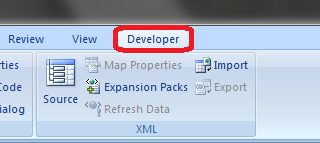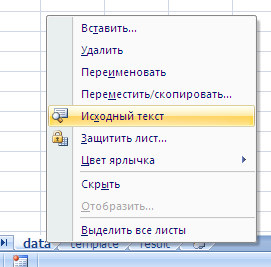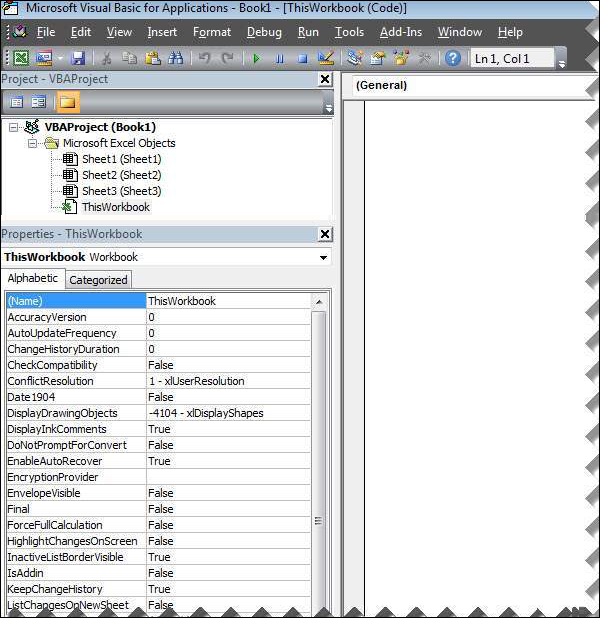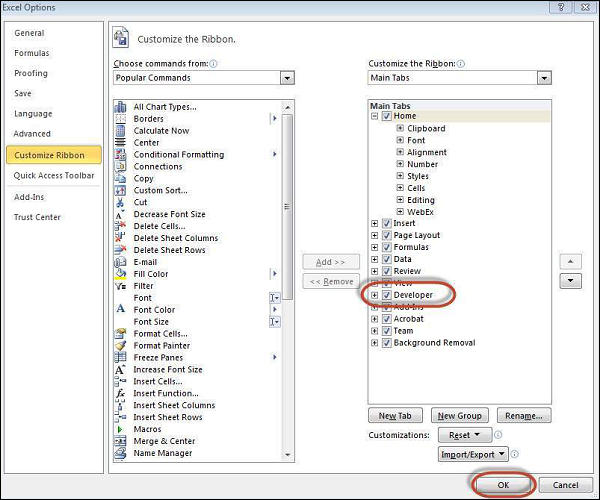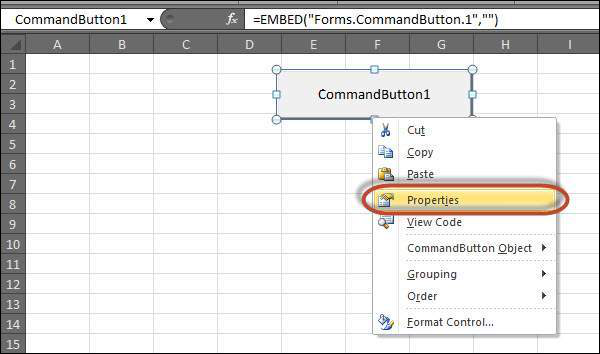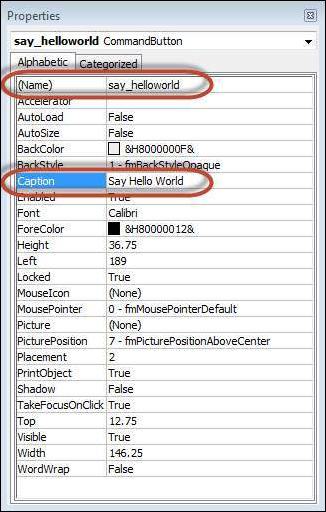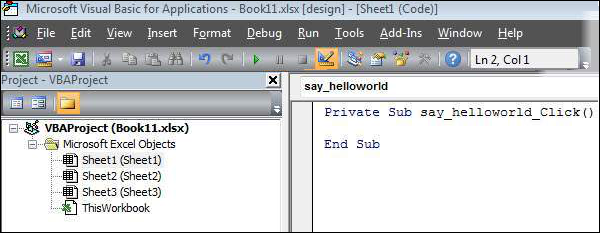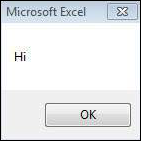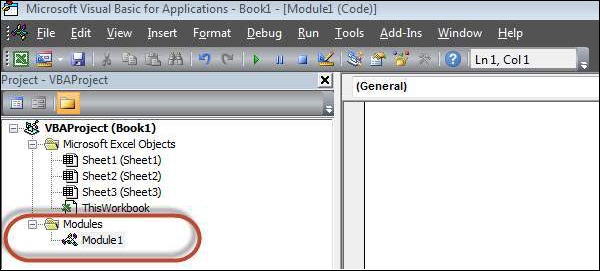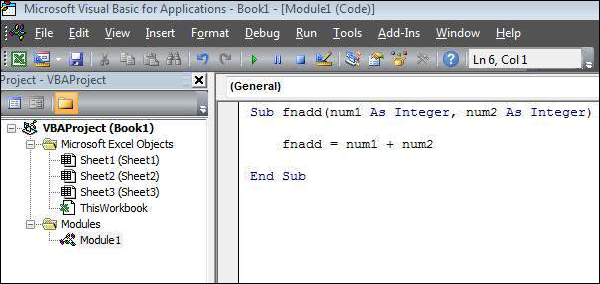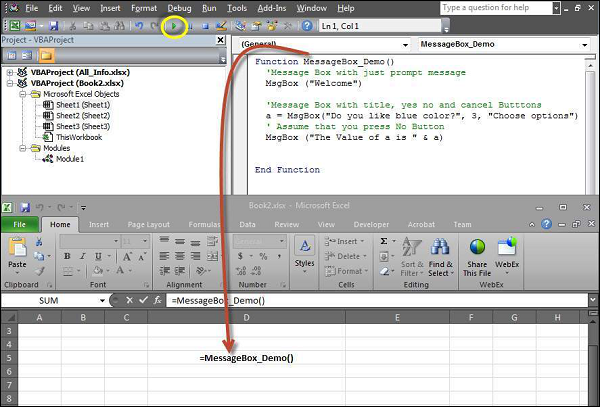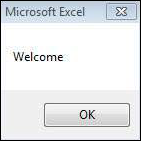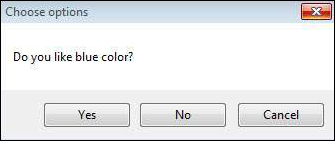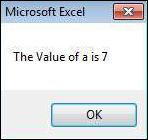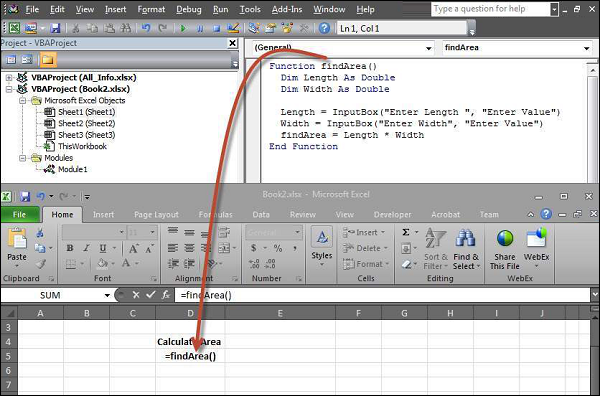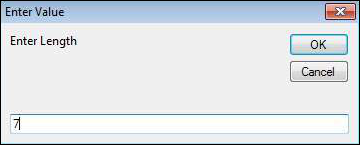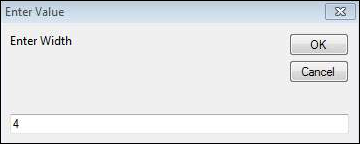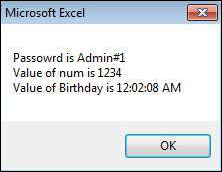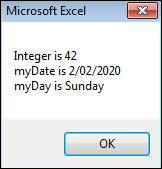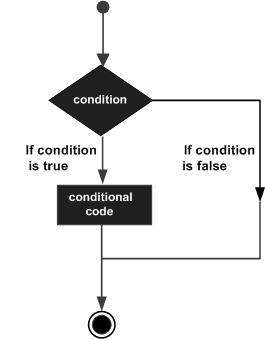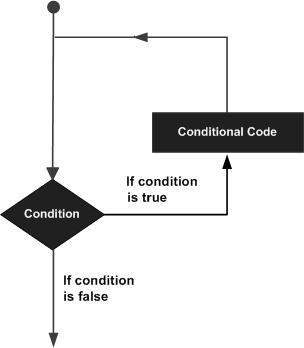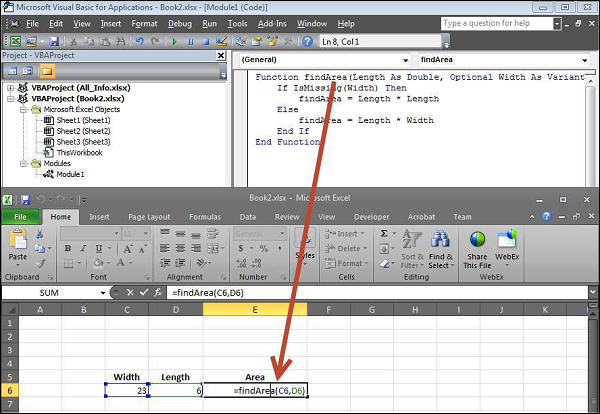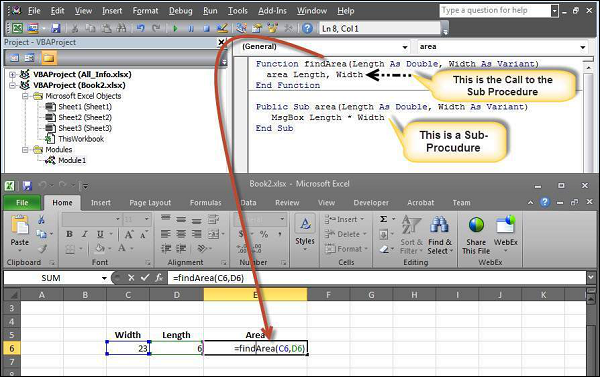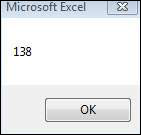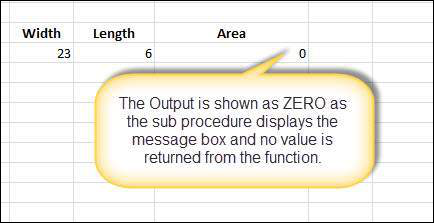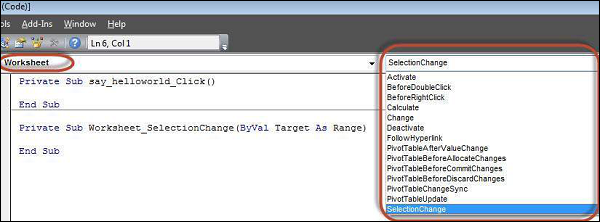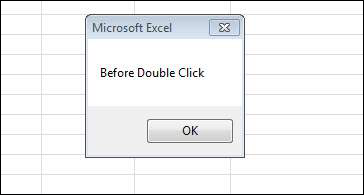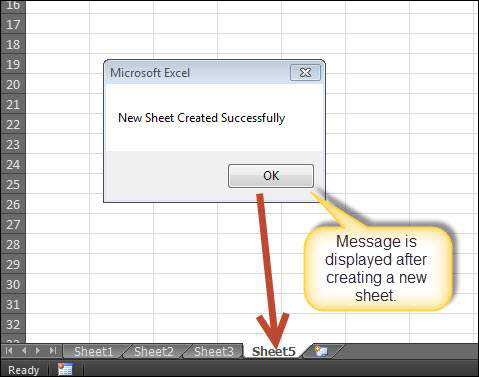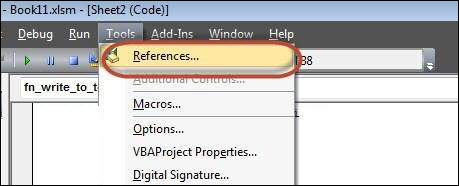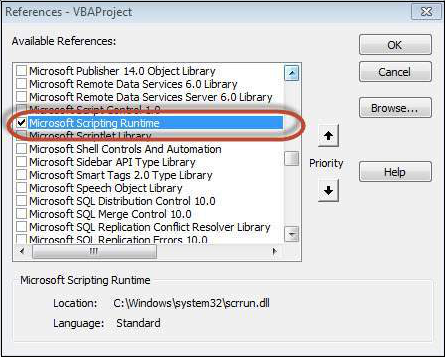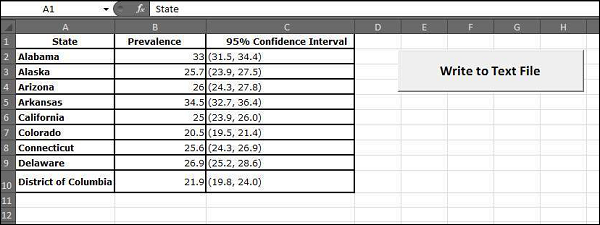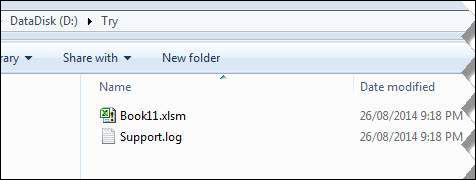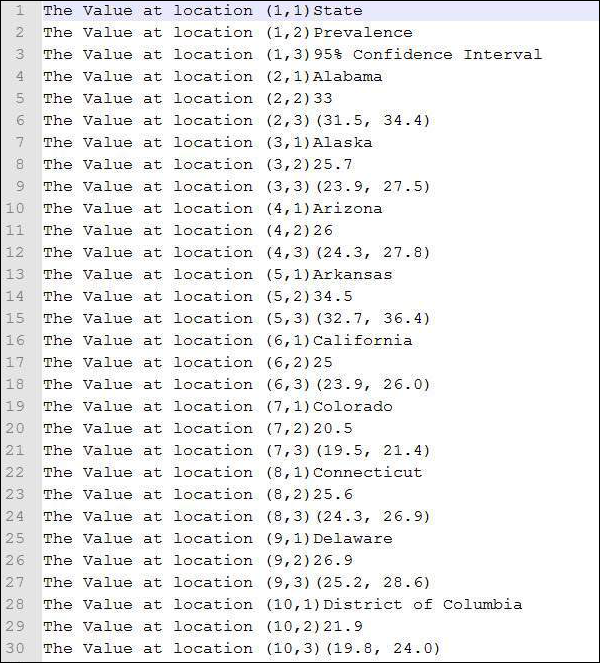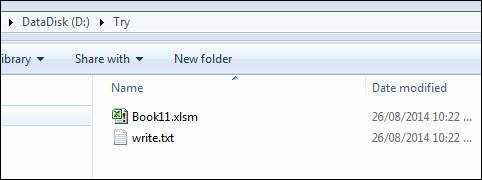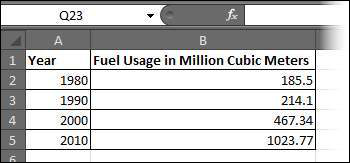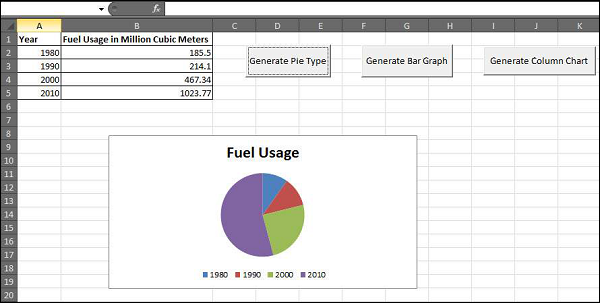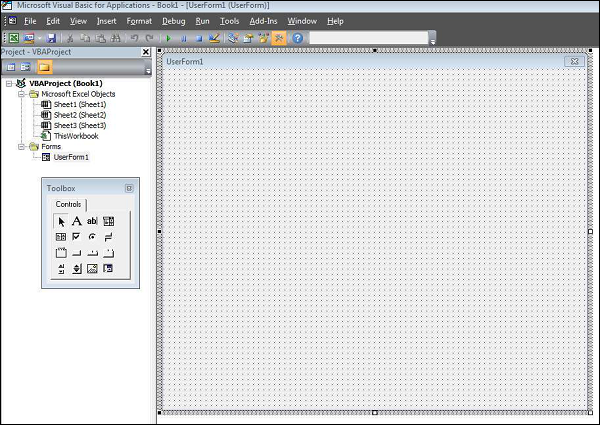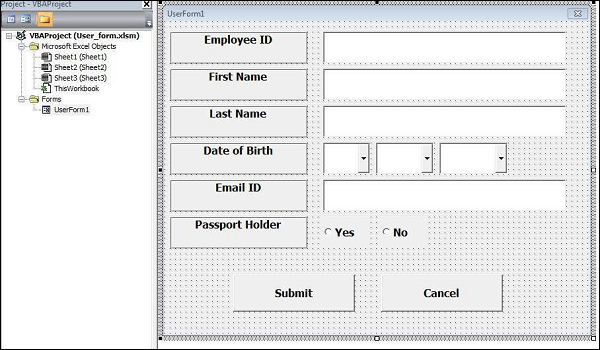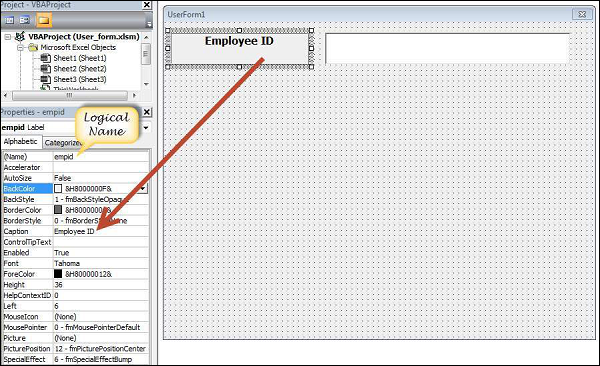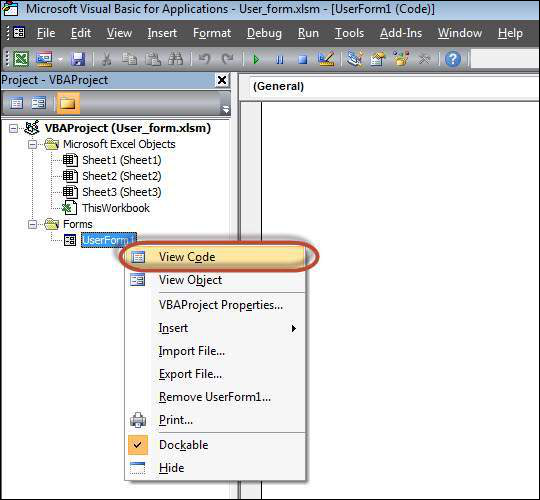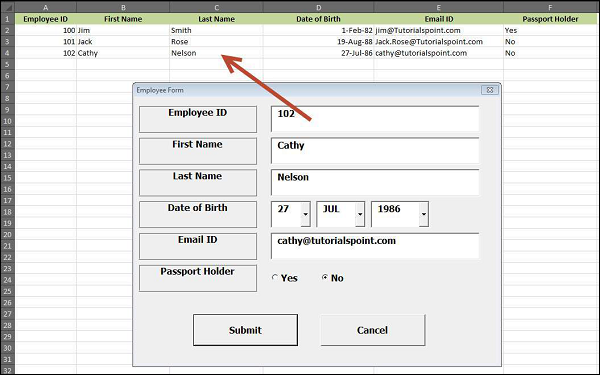“What do VBA and Office Scripts have in common?”
- VBA and Office Scripts are used to automate common, repetitive tasks.
- The target audience for both tools is business users. It is not required that the user be an experienced programmer, but programmers will have an easier time learning the tools.
“Where do VBA and Office Scripts differ?”
- VBA is limited to use in the desktop application space. VBA is not supported in the Web version of Office or when using Microsoft Teams.
- Office Scripts are currently limited to use in the Web version of Office applications and Microsoft Teams, but it is likely that Office Script functionality will eventually migrate down to the desktop application environment.
Based on the above statements, it appears as though one of these tools has a brighter future than the other. Can you guess which?
Examples of VBA and Desktop Macros
Simple VBA Macros
Below is a dataset and a chart. The chart was created from the dataset using a pre-recorded VBA macro.
The macro was written in such a way that it can dynamically detect the number of rows in the data and build the chart accordingly.
Creating the macro was done using a tool called the Macro Recorder. This tool writes the VBA code for us based on observing which buttons are pushed and what data is selected. It did require a small amount of hand-coding to dynamically determine the data range, but the vast majority was created without needing any knowledge of the VBA language.
This macro is showcased in a previous post/video. If you are interested in learning how this was made, click the following link for a complete, step-by-step tutorial and video on the construction of the macro and chart.
Running a VBA Macro
Macros can be launched in a variety of methods:
- Select View -> Macros -> View Macros -> {select macro by name} -> OK.
- Selecting Developer -> Macros -> {select macro by name} -> Run.
- Assign a shortcut key (ex: CTRL-r).
- Assign a launch button to the Quick Access Toolbar.
- Assign a launch button to a ribbon.
More exotic users may even assign macros to shapes, images, or icons that when clicked will execute the macro. Those are the REALLY cool kids.
Complex VBA Macros
VBA Macros can be as simple or as complex as you need them to be.
Below is an example of a set of macros that solicit the user for a data file, create a report based on the user’s needed topic, export the results a data file or PDF, etc.
The user clicks code launch buttons to execute specific tasks in any order they choose.
The macros can perform tasks in a variety of order and purpose. This makes for a highly dynamic environment where the output can be different from use to use. The logic is not confined to a predetermined linear path.
Unlike the simple VBA macro example, this solution can’t be created using the Macro Recorder. The branching logic, process looping, and user prompts are too complex and require hand-crafted code to operate properly.
If you are interested in learning how to write VBA code like the example above, check out my full VBA course on the XelPlus website.
Unlock Excel VBA & Excel Macros
Office Scripts
Remember, Office Scripts are only available when using Excel (or other Office 365 applications) on the Web.
Login to the Office.com website with your Microsoft 365 account, launch Excel for the Web, and start a blank workbook.
Select the Automate tab.
From here, you can record your actions, view your scripts, or try out some pre-recorded scripts.
NOTE: If you do not have the Automate table it is because either your network administrator has deactivated this feature via a policy, or you don’t have a Microsoft 365 Business or Enterprise account.
Recording an Office Scripts “Macro”
Just like in Excel and VBA, we can record a “macro”, or in this case, a script.
This tool will automatically generate the necessary code based on your actions.
The “Record Actions” feature isn’t as sensitive as the VBA Recorder; some actions are not recorded using this tool. Admittedly, the VBA Recorder doesn’t catch every action either, but it is a bit more robust than the “Record Actions” feature.
Keep in mind, Office Scripts is still in its infancy compared to VBA which has been around for decades and has seen dozens of development cycles.
The fact that we have a script recorder at all makes it easier for business users to begin learning the underlying code.
Recording a Script
We can record a simple Office Script by pressing the “Record Actions” button, then perform a series of common tasks, such as:
- Enter text in cells, like titles and subtitles.
- Make the text bold.
- Change the text color.
- Change the font size.
- Add a border to the title.
The above actions are recorded by the script recorder and listed on the right of the window.
We stop the recorder and give the script the name “Formatting”.
Clicking the Edit button will display the underlying script code.
The code is written in a language called TypeScript which is a superset of JavaScript which adds optional static typing to the language.
You can write traditional JavaScript in the code window if needed.
Automatic Documentation
A fantastic feature of the script recorder is the inclusion of automatic comments to document the code in a more natural language format.
“Where are Scripts Saved?”
Scripts are saved in a file that is separate from the Excel file from which it was created. The scripts are saved in a file named “OfficeScripts” in a folder on your OneDrive site.
This means that the script is easily repurposed for use in any other Excel file. This is like storing VBA Macros in the Personal Macro Workbook.
The scripts can be connected to a file, so it travels with the file when shared with other users.
I can go to any other Excel file and run this script from the Automate ribbon.
“What about looping, IF statements, & more complex code?”
More complex code can be hand-crafted in the Code Editor, but there are many differences between VBA and TypeScript.
One difference is object selection. In VBA, if you perform an action, like selecting a cell, and you do not tell VBA which sheet holds the target cell, VBA assumes you want the cell on the currently selected sheet (i.e., the Active Sheet).
In TypeScript, you are required to tell the code which sheet you wish to manipulate.
Another HUGE difference between VBA and Office Scripts is the method by which target ranges are selected.
If we wish to get the cell address of the first cell on the sheet (the cell in the first column and the first row), we could write a statement like the following.
let MyAddress = selectedSheet.getCell(1,1).getAddress()We will display the results using the Console Log feature. This will display the results on the screen in the Code Editor panel.
console.log(MyAddress)If we ran our code on a sheet named “Sheet3” we will see the following result.
Notice that TypeScript thinks that the cell on Row 1 and Column 1 is cell B3. This appears to be incorrect.
The issue is that Office Scripts is a zero-based language; it starts counting at 0 (zero) instead of 1 like VBA.
We need to adjust our brains to remember to offset the position value by one, like in the following example.
let MyAddress = selectedSheet.getCell(0,0).getAddress()Office Scripts Limitations
Remember when we launched a VBA Macro we had many ways to perform this task, like assign macros to icons and launch buttons.
Sadly, we are not able to attach Office Scripts to shapes and icons. This functionality will hopefully appear in a future update.
Another limitation is the inability to have pop-up boxes and message boxes.
We are also restricted from using Events to trigger the execution of scripts. Excel can launch a macro based on an event, like the contents of a cell changing or the selection of a sheet.
That doesn’t mean it’s all bad news.
We can use Power Automate to trigger a script’s execution. This means we don’t even have to have Excel open to run a script.
We use Power Automate based on a trigger. The trigger can be a scheduled time, the receipt of an Outlook email, the selection of specific rows in a different Excel file. The list of trigger options is vast and ever-growing.
“What’s in store for the future?”
In an upcoming video (next week) we will look at how to create a column chart using dynamic ranges. We will use the Script Recorder to write most of the needed code, then we will make some minor adjustments to the code to make it more dynamic.
“Is this the end of VBA?”
Are Office Scripts destined to replace VBA? I think eventually yes, but not any time soon.
Many companies use the Desktop version of Excel, a domain where Office Scripts currently have no residence.
Many companies will not be upgrading to Office 365.
Much time and money have been invested in complex VBA solutions to automate many business processes. These processes cannot at present be upgraded to Office Scripts due to incompatibility or lack of features.
Likely, VBA will still be around for another decade or so.
Published on: May 24, 2021
Last modified: February 21, 2023
Leila Gharani
I’m a 5x Microsoft MVP with over 15 years of experience implementing and professionals on Management Information Systems of different sizes and nature.
My background is Masters in Economics, Economist, Consultant, Oracle HFM Accounting Systems Expert, SAP BW Project Manager. My passion is teaching, experimenting and sharing. I am also addicted to learning and enjoy taking online courses on a variety of topics.
Время на прочтение
7 мин
Количество просмотров 312K
Приветствую всех.
В этом посте я расскажу, что такое VBA и как с ним работать в Microsoft Excel 2007/2010 (для более старых версий изменяется лишь интерфейс — код, скорее всего, будет таким же) для автоматизации различной рутины.

VBA (Visual Basic for Applications) — это упрощенная версия Visual Basic, встроенная в множество продуктов линейки Microsoft Office. Она позволяет писать программы прямо в файле конкретного документа. Вам не требуется устанавливать различные IDE — всё, включая отладчик, уже есть в Excel.
Еще при помощи Visual Studio Tools for Office можно писать макросы на C# и также встраивать их. Спасибо, FireStorm.
Сразу скажу — писать на других языках (C++/Delphi/PHP) также возможно, но требуется научится читать, изменять и писать файлы офиса — встраивать в документы не получится. А интерфейсы Microsoft работают через COM. Чтобы вы поняли весь ужас, вот Hello World с использованием COM.
Поэтому, увы, будем учить Visual Basic.
Чуть-чуть подготовки и постановка задачи
Итак, поехали. Открываем Excel.
Для начала давайте добавим в Ribbon панель «Разработчик». В ней находятся кнопки, текстовые поля и пр. элементы для конструирования форм.
Появилась вкладка.
Теперь давайте подумаем, на каком примере мы будем изучать VBA. Недавно мне потребовалось красиво оформить прайс-лист, выглядевший, как таблица. Идём в гугл, набираем «прайс-лист» и качаем любой, который оформлен примерно так (не сочтите за рекламу, пожалуйста):
То есть требуется, чтобы было как минимум две группы, по которым можно объединить товары (в нашем случае это будут Тип и Производитель — в таком порядке). Для того, чтобы предложенный мною алгоритм работал корректно, отсортируйте товары так, чтобы товары из одной группы стояли подряд (сначала по Типу, потом по Производителю).
Результат, которого хотим добиться, выглядит примерно так:
Разумеется, если смотреть прайс только на компьютере, то можно добавить фильтры и будет гораздо удобнее искать нужный товар. Однако мы хотим научится кодить и задача вполне подходящая, не так ли?
Кодим
Для начала требуется создать кнопку, при нажатии на которую будет вызываться наша програма. Кнопки находятся в панели «Разработчик» и появляются по кнопке «Вставить». Вам нужен компонент формы «Кнопка». Нажали, поставили на любое место в листе. Далее, если не появилось окно назначения макроса, надо нажать правой кнопкой и выбрать пункт «Назначить макрос». Назовём его FormatPrice. Важно, чтобы перед именем макроса ничего не было — иначе он создастся в отдельном модуле, а не в пространстве имен книги. В этому случае вам будет недоступно быстрое обращение к выделенному листу. Нажимаем кнопку «Новый».
И вот мы в среде разработки VB. Также её можно вызвать из контекстного меню командой «Исходный текст»/«View code».
Перед вами окно с заглушкой процедуры. Можете его развернуть. Код должен выглядеть примерно так:
Sub FormatPrice()End Sub
Напишем Hello World:
Sub FormatPrice()
MsgBox "Hello World!"
End Sub
И запустим либо щелкнув по кнопке (предварительно сняв с неё выделение), либо клавишей F5 прямо из редактора.
Тут, пожалуй, следует отвлечься на небольшой ликбез по поводу синтаксиса VB. Кто его знает — может смело пропустить этот раздел до конца. Основное отличие Visual Basic от Pascal/C/Java в том, что команды разделяются не ;, а переносом строки или двоеточием (:), если очень хочется написать несколько команд в одну строку. Чтобы понять основные правила синтаксиса, приведу абстрактный код.
Примеры синтаксиса
' Процедура. Ничего не возвращает
' Перегрузка в VBA отсутствует
Sub foo(a As String, b As String)
' Exit Sub ' Это значит "выйти из процедуры"
MsgBox a + ";" + b
End Sub' Функция. Вовращает Integer
Function LengthSqr(x As Integer, y As Integer) As Integer
' Exit Function
LengthSqr = x * x + y * y
End FunctionSub FormatPrice()
Dim s1 As String, s2 As String
s1 = "str1"
s2 = "str2"
If s1 <> s2 Then
foo "123", "456" ' Скобки при вызове процедур запрещены
End IfDim res As sTRING ' Регистр в VB не важен. Впрочем, редактор Вас поправит
Dim i As Integer
' Цикл всегда состоит из нескольких строк
For i = 1 To 10
res = res + CStr(i) ' Конвертация чего угодно в String
If i = 5 Then Exit For
Next iDim x As Double
x = Val("1.234") ' Парсинг чисел
x = x + 10
MsgBox xOn Error Resume Next ' Обработка ошибок - игнорировать все ошибки
x = 5 / 0
MsgBox xOn Error GoTo Err ' При ошибке перейти к метке Err
x = 5 / 0
MsgBox "OK!"
GoTo ne
Err:
MsgBox
"Err!"
ne:
On Error GoTo 0 ' Отключаем обработку ошибок
' Циклы бывает, какие захотите
Do While True
Exit DoLoop 'While True
Do 'Until False
Exit Do
Loop Until False
' А вот при вызове функций, от которых хотим получить значение, скобки нужны.
' Val также умеет возвращать Integer
Select Case LengthSqr(Len("abc"), Val("4"))
Case 24
MsgBox "0"
Case 25
MsgBox "1"
Case 26
MsgBox "2"
End Select' Двухмерный массив.
' Можно также менять размеры командой ReDim (Preserve) - см. google
Dim arr(1 to 10, 5 to 6) As Integer
arr(1, 6) = 8Dim coll As New Collection
Dim coll2 As Collection
coll.Add "item", "key"
Set coll2 = coll ' Все присваивания объектов должны производится командой Set
MsgBox coll2("key")
Set coll2 = New Collection
MsgBox coll2.Count
End Sub
Грабли-1. При копировании кода из IDE (в английском Excel) есь текст конвертируется в 1252 Latin-1. Поэтому, если хотите сохранить русские комментарии — надо сохранить крокозябры как Latin-1, а потом открыть в 1251.
Грабли-2. Т.к. VB позволяет использовать необъявленные переменные, я всегда в начале кода (перед всеми процедурами) ставлю строчку Option Explicit. Эта директива запрещает интерпретатору заводить переменные самостоятельно.
Грабли-3. Глобальные переменные можно объявлять только до первой функции/процедуры. Локальные — в любом месте процедуры/функции.
Еще немного дополнительных функций, которые могут пригодится: InPos, Mid, Trim, LBound, UBound. Также ответы на все вопросы по поводу работы функций/их параметров можно получить в MSDN.
Надеюсь, что этого Вам хватит, чтобы не пугаться кода и самостоятельно написать какое-нибудь домашнее задание по информатике. По ходу поста я буду ненавязчиво знакомить Вас с новыми конструкциями.
Кодим много и под Excel
В этой части мы уже начнём кодить нечто, что умеет работать с нашими листами в Excel. Для начала создадим отдельный лист с именем result (лист с данными назовём data). Теперь, наверное, нужно этот лист очистить от того, что на нём есть. Также мы «выделим» лист с данными, чтобы каждый раз не писать длинное обращение к массиву с листами.
Sub FormatPrice()
Sheets("result").Cells.Clear
Sheets("data").Activate
End Sub
Работа с диапазонами ячеек
Вся работа в Excel VBA производится с диапазонами ячеек. Они создаются функцией Range и возвращают объект типа Range. У него есть всё необходимое для работы с данными и/или оформлением. Кстати сказать, свойство Cells листа — это тоже Range.
Примеры работы с Range
Sheets("result").Activate
Dim r As Range
Set r = Range("A1")
r.Value = "123"
Set r = Range("A3,A5")
r.Font.Color = vbRed
r.Value = "456"
Set r = Range("A6:A7")
r.Value = "=A1+A3"
Теперь давайте поймем алгоритм работы нашего кода. Итак, у каждой строчки листа data, начиная со второй, есть некоторые данные, которые нас не интересуют (ID, название и цена) и есть две вложенные группы, к которым она принадлежит (тип и производитель). Более того, эти строки отсортированы. Пока мы забудем про пропуски перед началом новой группы — так будет проще. Я предлагаю такой алгоритм:
- Считали группы из очередной строки.
- Пробегаемся по всем группам в порядке приоритета (вначале более крупные)
- Если текущая группа не совпадает, вызываем процедуру AddGroup(i, name), где i — номер группы (от номера текущей до максимума), name — её имя. Несколько вызовов необходимы, чтобы создать не только наш заголовок, но и всё более мелкие.
- После отрисовки всех необходимых заголовков делаем еще одну строку и заполняем её данными.
Для упрощения работы рекомендую определить следующие функции-сокращения:
Function GetCol(Col As Integer) As String
GetCol = Chr(Asc("A") + Col)
End FunctionFunction GetCellS(Sheet As String, Col As Integer, Row As Integer) As Range
Set GetCellS = Sheets(Sheet).Range(GetCol(Col) + CStr(Row))
End FunctionFunction GetCell(Col As Integer, Row As Integer) As Range
Set GetCell = Range(GetCol(Col) + CStr(Row))
End Function
Далее определим глобальную переменную «текущая строчка»: Dim CurRow As Integer. В начале процедуры её следует сделать равной единице. Еще нам потребуется переменная-«текущая строка в data», массив с именами групп текущей предыдущей строк. Потом можно написать цикл «пока первая ячейка в строке непуста».
Глобальные переменные
Option Explicit ' про эту строчку я уже рассказывал
Dim CurRow As Integer
Const GroupsCount As Integer = 2
Const DataCount As Integer = 3
FormatPrice
Sub FormatPrice()
Dim I As Integer ' строка в data
CurRow = 1
Dim Groups(1 To GroupsCount) As String
Dim PrGroups(1 To GroupsCount) As String
Sheets(
"data").Activate
I = 2
Do While True
If GetCell(0, I).Value = "" Then Exit Do
' ...
I = I + 1
Loop
End Sub
Теперь надо заполнить массив Groups:
На месте многоточия
Dim I2 As Integer
For I2 = 1 To GroupsCount
Groups(I2) = GetCell(I2, I)
Next I2
' ...
For I2 = 1 To GroupsCount ' VB не умеет копировать массивы
PrGroups(I2) = Groups(I2)
Next I2
I = I + 1
И создать заголовки:
На месте многоточия в предыдущем куске
For I2 = 1 To GroupsCount
If Groups(I2) <> PrGroups(I2) Then
Dim I3 As Integer
For I3 = I2 To GroupsCount
AddHeader I3, Groups(I3)
Next I3
Exit For
End If
Next I2
Не забудем про процедуру AddHeader:
Перед FormatPrice
Sub AddHeader(Ty As Integer, Name As String)
GetCellS("result", 1, CurRow).Value = Name
CurRow = CurRow + 1
End Sub
Теперь надо перенести всякую информацию в result
For I2 = 0 To DataCount - 1
GetCellS("result", I2, CurRow).Value = GetCell(I2, I)
Next I2
Подогнать столбцы по ширине и выбрать лист result для показа результата
После цикла в конце FormatPrice
Sheets("Result").Activate
Columns.AutoFit
Всё. Можно любоваться первой версией.
Некрасиво, но похоже. Давайте разбираться с форматированием. Сначала изменим процедуру AddHeader:
Sub AddHeader(Ty As Integer, Name As String)
Sheets("result").Range("A" + CStr(CurRow) + ":C" + CStr(CurRow)).Merge
' Чтобы не заводить переменную и не писать каждый раз длинный вызов
' можно воспользоваться блоком With
With GetCellS("result", 0, CurRow)
.Value = Name
.Font.Italic = True
.Font.Name = "Cambria"
Select Case Ty
Case 1 ' Тип
.Font.Bold = True
.Font.Size = 16
Case 2 ' Производитель
.Font.Size = 12
End Select
.HorizontalAlignment = xlCenter
End With
CurRow = CurRow + 1
End Sub
Уже лучше:
Осталось только сделать границы. Тут уже нам требуется работать со всеми объединёнными ячейками, иначе бордюр будет только у одной:
Поэтому чуть-чуть меняем код с добавлением стиля границ:
Sub AddHeader(Ty As Integer, Name As String)
With Sheets("result").Range("A" + CStr(CurRow) + ":C" + CStr(CurRow))
.Merge
.Value = Name
.Font.Italic = True
.Font.Name = "Cambria"
.HorizontalAlignment = xlCenterSelect Case Ty
Case 1 ' Тип
.Font.Bold = True
.Font.Size = 16
.Borders(xlTop).Weight = xlThick
Case 2 ' Производитель
.Font.Size = 12
.Borders(xlTop).Weight = xlMedium
End Select
.Borders(xlBottom).Weight = xlMedium ' По убыванию: xlThick, xlMedium, xlThin, xlHairline
End With
CurRow = CurRow + 1
End Sub
Осталось лишь добится пропусков перед началом новой группы. Это легко:
В начале FormatPrice
Dim I As Integer ' строка в data
CurRow = 0 ' чтобы не было пропуска в самом начале
Dim Groups(1 To GroupsCount) As String
В цикле расстановки заголовков
If Groups(I2) <> PrGroups(I2) Then
CurRow = CurRow + 1
Dim I3 As Integer
В точности то, что и хотели.
Надеюсь, что эта статья помогла вам немного освоится с программированием для Excel на VBA. Домашнее задание — добавить заголовки «ID, Название, Цена» в результат. Подсказка: CurRow = 0 CurRow = 1.
Файл можно скачать тут (min.us) или тут (Dropbox). Не забудьте разрешить исполнение макросов. Если кто-нибудь подскажет человеческих файлохостинг, залью туда.
Спасибо за внимание.
Буду рад конструктивной критике в комментариях.
UPD: Перезалил пример на Dropbox и min.us.
UPD2: На самом деле, при вызове процедуры с одним параметром скобки можно поставить. Либо использовать конструкцию Call Foo(«bar», 1, 2, 3) — тут скобки нужны постоянно.
VBA — Overview
VBA stands for Visual Basic for Applications an event-driven programming language from Microsoft that is now predominantly used with Microsoft office applications such as MSExcel, MS-Word, and MS-Access.
It helps techies to build customized applications and solutions to enhance the capabilities of those applications. The advantage of this facility is that you NEED NOT have visual basic installed on our PC, however, installing Office will implicitly help in achieving the purpose.
You can use VBA in all office versions, right from MS-Office 97 to MS-Office 2013 and also with any of the latest versions available. Among VBA, Excel VBA is the most popular. The advantage of using VBA is that you can build very powerful tools in MS Excel using linear programming.
Application of VBA
You might wonder why to use VBA in Excel as MS-Excel itself provides loads of inbuilt functions. MS-Excel provides only basic inbuilt functions which might not be sufficient to perform complex calculations. Under such circumstances, VBA becomes the most obvious solution.
For example, it is very hard to calculate the monthly repayment of a loan using Excel’s built-in formulas. Rather, it is easy to program a VBA for such a calculation.
Accessing VBA Editor
In Excel window, press «ALT+F11». A VBA window opens up as shown in the following screenshot.
VBA — Excel Macros
In this chapter, you will learn how to write a simple macro in a step by step manner.
Step 1 − First, enable ‘Developer’ menu in Excel 20XX. To do the same, click File → Options.
Step 2 − Click ‘Customize the Ribbon’ tab and check ‘Developer’. Click ‘OK’.
Step 3 − The ‘Developer’ ribbon appears in the menu bar.
Step 4 − Click the ‘Visual Basic’ button to open the VBA Editor.
Step 5 − Start scripting by adding a button. Click Insert → Select the button.
Step 6 − Perform a right-click and choose ‘properties’.
Step 7 − Edit the name and caption as shown in the following screenshot.
Step 8 − Now double-click the button and the sub-procedure outline will be displayed as shown in the following screenshot.
Step 9 − Start coding by simply adding a message.
Private Sub say_helloworld_Click() MsgBox "Hi" End Sub
Step 10 − Click the button to execute the sub-procedure. The output of the sub-procedure is shown in the following screenshot. Make sure that you do have design mode turned on. Simply click it to turn it on if it is not on.
Note − In further chapters, we will demonstrate using a simple button, as explained from step#1 to 10. Hence , it is important to understand this chapter thoroughly.
VBA — Excel Terms
In this chapter, you will acquaint yourself with the commonly used excel VBA terminologies. These terminologies will be used in further modules, hence understanding each one of these is important.
Modules
Modules is the area where the code is written. This is a new Workbook, hence there aren’t any Modules.
To insert a Module, navigate to Insert → Module. Once a module is inserted ‘module1’ is created.
Within the modules, we can write VBA code and the code is written within a Procedure. A Procedure/Sub Procedure is a series of VBA statements instructing what to do.
Procedure
Procedures are a group of statements executed as a whole, which instructs Excel how to perform a specific task. The task performed can be a very simple or a very complicated task. However, it is a good practice to break down complicated procedures into smaller ones.
The two main types of Procedures are Sub and Function.
Function
A function is a group of reusable code, which can be called anywhere in your program. This eliminates the need of writing the same code over and over again. This helps the programmers to divide a big program into a number of small and manageable functions.
Apart from inbuilt Functions, VBA allows to write user-defined functions as well and statements are written between Function and End Function.
Sub-Procedures
Sub-procedures work similar to functions. While sub procedures DO NOT Return a value, functions may or may not return a value. Sub procedures CAN be called without call keyword. Sub procedures are always enclosed within Sub and End Sub statements.
VBA — Macro Comments
Comments are used to document the program logic and the user information with which other programmers can seamlessly work on the same code in future.
It includes information such as developed by, modified by, and can also include incorporated logic. Comments are ignored by the interpreter while execution.
Comments in VBA are denoted by two methods.
-
Any statement that starts with a Single Quote (‘) is treated as comment. Following is an example.
' This Script is invoked after successful login ' Written by : TutorialsPoint ' Return Value : True / False
-
Any statement that starts with the keyword «REM». Following is an example.
REM This Script is written to Validate the Entered Input REM Modified by : Tutorials point/user2
VBA — Message Box
The MsgBox function displays a message box and waits for the user to click a button and then an action is performed based on the button clicked by the user.
Syntax
MsgBox(prompt[,buttons][,title][,helpfile,context])
Parameter Description
-
Prompt − A Required Parameter. A String that is displayed as a message in the dialog box. The maximum length of prompt is approximately 1024 characters. If the message extends to more than a line, then the lines can be separated using a carriage return character (Chr(13)) or a linefeed character (Chr(10)) between each line.
-
Buttons − An Optional Parameter. A Numeric expression that specifies the type of buttons to display, the icon style to use, the identity of the default button, and the modality of the message box. If left blank, the default value for buttons is 0.
-
Title − An Optional Parameter. A String expression displayed in the title bar of the dialog box. If the title is left blank, the application name is placed in the title bar.
-
Helpfile − An Optional Parameter. A String expression that identifies the Help file to use for providing context-sensitive help for the dialog box.
-
Context − An Optional Parameter. A Numeric expression that identifies the Help context number assigned by the Help author to the appropriate Help topic. If context is provided, helpfile must also be provided.
The Buttons parameter can take any of the following values −
-
0 vbOKOnly — Displays OK button only.
-
1 vbOKCancel — Displays OK and Cancel buttons.
-
2 vbAbortRetryIgnore — Displays Abort, Retry, and Ignore buttons.
-
3 vbYesNoCancel — Displays Yes, No, and Cancel buttons.
-
4 vbYesNo — Displays Yes and No buttons.
-
5 vbRetryCancel — Displays Retry and Cancel buttons.
-
16 vbCritical — Displays Critical Message icon.
-
32 vbQuestion — Displays Warning Query icon.
-
48 vbExclamation — Displays Warning Message icon.
-
64 vbInformation — Displays Information Message icon.
-
0 vbDefaultButton1 — First button is default.
-
256 vbDefaultButton2 — Second button is default.
-
512 vbDefaultButton3 — Third button is default.
-
768 vbDefaultButton4 — Fourth button is default.
-
0 vbApplicationModal Application modal — The current application will not work until the user responds to the message box.
-
4096 vbSystemModal System modal — All applications will not work until the user responds to the message box.
The above values are logically divided into four groups: The first group (0 to 5) indicates the buttons to be displayed in the message box. The second group (16, 32, 48, 64) describes the style of the icon to be displayed, the third group (0, 256, 512, 768) indicates which button must be the default, and the fourth group (0, 4096) determines the modality of the message box.
Return Values
The MsgBox function can return one of the following values which can be used to identify the button the user has clicked in the message box.
- 1 — vbOK — OK was clicked
- 2 — vbCancel — Cancel was clicked
- 3 — vbAbort — Abort was clicked
- 4 — vbRetry — Retry was clicked
- 5 — vbIgnore — Ignore was clicked
- 6 — vbYes — Yes was clicked
- 7 — vbNo — No was clicked
Example
Function MessageBox_Demo()
'Message Box with just prompt message
MsgBox("Welcome")
'Message Box with title, yes no and cancel Butttons
int a = MsgBox("Do you like blue color?",3,"Choose options")
' Assume that you press No Button
msgbox ("The Value of a is " & a)
End Function
Output
Step 1 − The above Function can be executed either by clicking the «Run» button on VBA Window or by calling the function from Excel Worksheet as shown in the following screenshot.
Step 2 − A Simple Message box is displayed with a message «Welcome» and an «OK» Button
Step 3 − After Clicking OK, yet another dialog box is displayed with a message along with «yes, no, and cancel» buttons.
Step 4 − After clicking the ‘No’ button, the value of that button (7) is stored as an integer and displayed as a message box to the user as shown in the following screenshot. Using this value, it can be understood which button the user has clicked.
VBA — InputBox
The InputBox function prompts the users to enter values. After entering the values, if the user clicks the OK button or presses ENTER on the keyboard, the InputBox function will return the text in the text box. If the user clicks the Cancel button, the function will return an empty string («»).
Syntax
InputBox(prompt[,title][,default][,xpos][,ypos][,helpfile,context])
Parameter Description
-
Prompt − A required parameter. A String that is displayed as a message in the dialog box. The maximum length of prompt is approximately 1024 characters. If the message extends to more than a line, then the lines can be separated using a carriage return character (Chr(13)) or a linefeed character (Chr(10)) between each line.
-
Title − An optional parameter. A String expression displayed in the title bar of the dialog box. If the title is left blank, the application name is placed in the title bar.
-
Default − An optional parameter. A default text in the text box that the user would like to be displayed.
-
XPos − An optional parameter. The position of X axis represents the prompt distance from the left side of the screen horizontally. If left blank, the input box is horizontally centered.
-
YPos − An optional parameter. The position of Y axis represents the prompt distance from the left side of the screen vertically. If left blank, the input box is vertically centered.
-
Helpfile − An optional parameter. A String expression that identifies the helpfile to be used to provide context-sensitive Help for the dialog box.
-
context − An optional parameter. A Numeric expression that identifies the Help context number assigned by the Help author to the appropriate Help topic. If context is provided, helpfile must also be provided.
Example
Let us calculate the area of a rectangle by getting values from the user at run time with the help of two input boxes (one for length and one for width).
Function findArea()
Dim Length As Double
Dim Width As Double
Length = InputBox("Enter Length ", "Enter a Number")
Width = InputBox("Enter Width", "Enter a Number")
findArea = Length * Width
End Function
Output
Step 1 − To execute the same, call using the function name and press Enter as shown in the following screenshot.
Step 2 − Upon execution, the First input box (length) is displayed. Enter a value into the input box.
Step 3 − After entering the first value, the second input box (width) is displayed.
Step 4 − Upon entering the second number, click the OK button. The area is displayed as shown in the following screenshot.
VBA — Variables
Variable is a named memory location used to hold a value that can be changed during the script execution. Following are the basic rules for naming a variable.
-
You must use a letter as the first character.
-
You can’t use a space, period (.), exclamation mark (!), or the characters @, &, $, # in the name.
-
Name can’t exceed 255 characters in length.
-
You cannot use Visual Basic reserved keywords as variable name.
Syntax
In VBA, you need to declare the variables before using them.
Dim <<variable_name>> As <<variable_type>>
Data Types
There are many VBA data types, which can be divided into two main categories, namely numeric and non-numeric data types.
Numeric Data Types
Following table displays the numeric data types and the allowed range of values.
| Type | Range of Values |
|---|---|
| Byte | 0 to 255 |
| Integer | -32,768 to 32,767 |
| Long | -2,147,483,648 to 2,147,483,648 |
| Single |
-3.402823E+38 to -1.401298E-45 for negative values 1.401298E-45 to 3.402823E+38 for positive values. |
| Double |
-1.79769313486232e+308 to -4.94065645841247E-324 for negative values 4.94065645841247E-324 to 1.79769313486232e+308 for positive values. |
| Currency | -922,337,203,685,477.5808 to 922,337,203,685,477.5807 |
| Decimal |
+/- 79,228,162,514,264,337,593,543,950,335 if no decimal is use +/- 7.9228162514264337593543950335 (28 decimal places). |
Non-Numeric Data Types
Following table displays the non-numeric data types and the allowed range of values.
| Type | Range of Values |
|---|---|
| String (fixed length) | 1 to 65,400 characters |
| String (variable length) | 0 to 2 billion characters |
| Date | January 1, 100 to December 31, 9999 |
| Boolean | True or False |
| Object | Any embedded object |
| Variant (numeric) | Any value as large as double |
| Variant (text) | Same as variable-length string |
Example
Let us create a button and name it as ‘Variables_demo’ to demonstrate the use of variables.
Private Sub say_helloworld_Click()
Dim password As String
password = "Admin#1"
Dim num As Integer
num = 1234
Dim BirthDay As Date
BirthDay = DateValue("30 / 10 / 2020")
MsgBox "Passowrd is " & password & Chr(10) & "Value of num is " &
num & Chr(10) & "Value of Birthday is " & BirthDay
End Sub
Output
Upon executing the script, the output will be as shown in the following screenshot.
VBA — Constants
Constant is a named memory location used to hold a value that CANNOT be changed during the script execution. If a user tries to change a Constant value, the script execution ends up with an error. Constants are declared the same way the variables are declared.
Following are the rules for naming a constant.
-
You must use a letter as the first character.
-
You can’t use a space, period (.), exclamation mark (!), or the characters @, &, $, # in the name.
-
Name can’t exceed 255 characters in length.
-
You cannot use Visual Basic reserved keywords as variable name.
Syntax
In VBA, we need to assign a value to the declared Constants. An error is thrown, if we try to change the value of the constant.
Const <<constant_name>> As <<constant_type>> = <<constant_value>>
Example
Let us create a button «Constant_demo» to demonstrate how to work with constants.
Private Sub Constant_demo_Click()
Const MyInteger As Integer = 42
Const myDate As Date = #2/2/2020#
Const myDay As String = "Sunday"
MsgBox "Integer is " & MyInteger & Chr(10) & "myDate is "
& myDate & Chr(10) & "myDay is " & myDay
End Sub
Output
Upon executing the script, the output will be displayed as shown in the following screenshot.
VBA — Operators
An Operator can be defined using a simple expression — 4 + 5 is equal to 9. Here, 4 and 5 are called operands and + is called operator. VBA supports following types of operators −
- Arithmetic Operators
- Comparison Operators
- Logical (or Relational) Operators
- Concatenation Operators
The Arithmatic Operators
Following arithmetic operators are supported by VBA.
Assume variable A holds 5 and variable B holds 10, then −
Show Examples
| Operator | Description | Example |
|---|---|---|
| + | Adds the two operands | A + B will give 15 |
| — | Subtracts the second operand from the first | A — B will give -5 |
| * | Multiplies both the operands | A * B will give 50 |
| / | Divides the numerator by the denominator | B / A will give 2 |
| % | Modulus operator and the remainder after an integer division | B % A will give 0 |
| ^ | Exponentiation operator | B ^ A will give 100000 |
The Comparison Operators
There are following comparison operators supported by VBA.
Assume variable A holds 10 and variable B holds 20, then −
Show Examples
| Operator | Description | Example |
|---|---|---|
| = | Checks if the value of the two operands are equal or not. If yes, then the condition is true. | (A = B) is False. |
| <> | Checks if the value of the two operands are equal or not. If the values are not equal, then the condition is true. | (A <> B) is True. |
| > | Checks if the value of the left operand is greater than the value of the right operand. If yes, then the condition is true. | (A > B) is False. |
| < | Checks if the value of the left operand is less than the value of the right operand. If yes, then the condition is true. | (A < B) is True. |
| >= | Checks if the value of the left operand is greater than or equal to the value of the right operand. If yes, then the condition is true. | (A >= B) is False. |
| <= | Checks if the value of the left operand is less than or equal to the value of the right operand. If yes, then the condition is true. | (A <= B) is True. |
The Logical Operators
Following logical operators are supported by VBA.
Assume variable A holds 10 and variable B holds 0, then −
Show Examples
| Operator | Description | Example |
|---|---|---|
| AND | Called Logical AND operator. If both the conditions are True, then the Expression is true. | a<>0 AND b<>0 is False. |
| OR | Called Logical OR Operator. If any of the two conditions are True, then the condition is true. | a<>0 OR b<>0 is true. |
| NOT | Called Logical NOT Operator. Used to reverse the logical state of its operand. If a condition is true, then Logical NOT operator will make false. | NOT(a<>0 OR b<>0) is false. |
| XOR | Called Logical Exclusion. It is the combination of NOT and OR Operator. If one, and only one, of the expressions evaluates to be True, the result is True. | (a<>0 XOR b<>0) is true. |
The Concatenation Operators
Following Concatenation operators are supported by VBA.
Assume variable A holds 5 and variable B holds 10 then −
Show Examples
| Operator | Description | Example |
|---|---|---|
| + | Adds two Values as Variable. Values are Numeric | A + B will give 15 |
| & | Concatenates two Values | A & B will give 510 |
Assume variable A = «Microsoft» and variable B = «VBScript», then −
| Operator | Description | Example |
|---|---|---|
| + | Concatenates two Values | A + B will give MicrosoftVBScript |
| & | Concatenates two Values | A & B will give MicrosoftVBScript |
Note − Concatenation Operators can be used for both numbers and strings. The output depends on the context, if the variables hold numeric value or string value.
VBA — Decisions
Decision making allows the programmers to control the execution flow of a script or one of its sections. The execution is governed by one or more conditional statements.
Following is the general form of a typical decision making structure found in most of the programming languages.
VBA provides the following types of decision making statements. Click the following links to check their details.
| Sr.No. | Statement & Description |
|---|---|
| 1 |
if statement
An if statement consists of a Boolean expression followed by one or more statements. |
| 2 |
if..else statement
An if else statement consists of a Boolean expression followed by one or more statements. If the condition is True, the statements under If statements are executed. If the condition is false, the Else part of the script is executed. |
| 3 |
if…elseif..else statement
An if statement followed by one or more ElseIf statements, that consists of Boolean expressions and then followed by an optional else statement, which executes when all the condition become false. |
| 4 |
nested if statements
An if or elseif statement inside another if or elseif statement(s). |
| 5 |
switch statement
A switch statement allows a variable to be tested for equality against a list of values. |
VBA — Loops
There may be a situation when you need to execute a block of code several number of times. In general, statements are executed sequentially: The first statement in a function is executed first, followed by the second, and so on.
Programming languages provide various control structures that allow for more complicated execution paths.
A loop statement allows us to execute a statement or group of statements multiple times. Following is the general form of a loop statement in VBA.
VBA provides the following types of loops to handle looping requirements. Click the following links to check their detail.
| Sr.No. | Loop Type & Description |
|---|---|
| 1 |
for loop
Executes a sequence of statements multiple times and abbreviates the code that manages the loop variable. |
| 2 |
for ..each loop
This is executed if there is at least one element in the group and reiterated for each element in a group. |
| 3 |
while..wend loop
This tests the condition before executing the loop body. |
| 4 |
do..while loops
The do..While statements will be executed as long as the condition is True.(i.e.,) The Loop should be repeated till the condition is False. |
| 5 |
do..until loops
The do..Until statements will be executed as long as the condition is False.(i.e.,) The Loop should be repeated till the condition is True. |
Loop Control Statements
Loop control statements change execution from its normal sequence. When execution leaves a scope, all the remaining statements in the loop are NOT executed.
VBA supports the following control statements. Click the following links to check their detail.
| S.No. | Control Statement & Description |
|---|---|
| 1 |
Exit For statement
Terminates the For loop statement and transfers the execution to the statement immediately following the loop |
| 2 |
Exit Do statement
Terminates the Do While statement and transfers the execution to the statement immediately following the loop |
VBA — Strings
Strings are a sequence of characters, which can consist of either alphabets, numbers, special characters, or all of them. A variable is said to be a string if it is enclosed within double quotes » «.
Syntax
variablename = "string"
Examples
str1 = "string" ' Only Alphabets str2 = "132.45" ' Only Numbers str3 = "!@#$;*" ' Only Special Characters Str4 = "Asc23@#" ' Has all the above
String Functions
There are predefined VBA String functions, which help the developers to work with the strings very effectively. Following are String methods that are supported in VBA. Please click on each one of the methods to know in detail.
| Sr.No. | Function Name & Description |
|---|---|
| 1 |
InStr
Returns the first occurrence of the specified substring. Search happens from the left to the right. |
| 2 |
InstrRev
Returns the first occurrence of the specified substring. Search happens from the right to the left. |
| 3 |
Lcase
Returns the lower case of the specified string. |
| 4 |
Ucase
Returns the upper case of the specified string. |
| 5 | Left
Returns a specific number of characters from the left side of the string. |
| 6 | Right
Returns a specific number of characters from the right side of the string. |
| 7 |
Mid
Returns a specific number of characters from a string based on the specified parameters. |
| 8 |
Ltrim
Returns a string after removing the spaces on the left side of the specified string. |
| 9 |
Rtrim
Returns a string after removing the spaces on the right side of the specified string. |
| 10 |
Trim
Returns a string value after removing both the leading and the trailing blank spaces. |
| 11 |
Len
Returns the length of the given string. |
| 12 |
Replace
Returns a string after replacing a string with another string. |
| 13 |
Space
Fills a string with the specified number of spaces. |
| 14 |
StrComp
Returns an integer value after comparing the two specified strings. |
| 15 |
String
Returns a string with a specified character for specified number of times. |
| 16 |
StrReverse
Returns a string after reversing the sequence of the characters of the given string. |
VBA — Date-Time Function
VBScript Date and Time Functions help the developers to convert date and time from one format to another or to express the date or time value in the format that suits a specific condition.
Date Functions
| Sr.No. | Function & Description |
|---|---|
| 1 |
Date
A Function, which returns the current system date. |
| 2 |
CDate
A Function, which converts a given input to date. |
| 3 |
DateAdd
A Function, which returns a date to which a specified time interval has been added. |
| 4 |
DateDiff
A Function, which returns the difference between two time period. |
| 5 |
DatePart
A Function, which returns a specified part of the given input date value. |
| 6 |
DateSerial
A Function, which returns a valid date for the given year, month, and date. |
| 7 |
FormatDateTime
A Function, which formats the date based on the supplied parameters. |
| 8 |
IsDate
A Function, which returns a Boolean Value whether or not the supplied parameter is a date. |
| 9 |
Day
A Function, which returns an integer between 1 and 31 that represents the day of the specified date. |
| 10 |
Month
A Function, which returns an integer between 1 and 12 that represents the month of the specified date. |
| 11 |
Year
A Function, which returns an integer that represents the year of the specified date. |
| 12 |
MonthName
A Function, which returns the name of the particular month for the specified date. |
| 13 |
WeekDay
A Function, which returns an integer(1 to 7) that represents the day of the week for the specified day. |
| 14 |
WeekDayName
A Function, which returns the weekday name for the specified day. |
Time Functions
| Sr.No. | Function & Description |
|---|---|
| 1 |
Now
A Function, which returns the current system date and time. |
| 2 |
Hour
A Function, which returns an integer between 0 and 23 that represents the hour part of the given time. |
| 3 |
Minute
A Function, which returns an integer between 0 and 59 that represents the minutes part of the given time. |
| 4 | Second
A Function, which returns an integer between 0 and 59 that represents the seconds part of the given time. |
| 5 | Time
A Function, which returns the current system time. |
| 6 |
Timer
A Function, which returns the number of seconds and milliseconds since 12:00 AM. |
| 7 |
TimeSerial
A Function, which returns the time for the specific input of hour, minute and second. |
| 8 |
TimeValue
A Function, which converts the input string to a time format. |
VBA — Arrays
We know very well that a variable is a container to store a value. Sometimes, developers are in a position to hold more than one value in a single variable at a time. When a series of values are stored in a single variable, then it is known as an array variable.
Array Declaration
Arrays are declared the same way a variable has been declared except that the declaration of an array variable uses parenthesis. In the following example, the size of the array is mentioned in the brackets.
'Method 1 : Using Dim
Dim arr1() 'Without Size
'Method 2 : Mentioning the Size
Dim arr2(5) 'Declared with size of 5
'Method 3 : using 'Array' Parameter
Dim arr3
arr3 = Array("apple","Orange","Grapes")
-
Although, the array size is indicated as 5, it can hold 6 values as array index starts from ZERO.
-
Array Index cannot be negative.
-
VBScript Arrays can store any type of variable in an array. Hence, an array can store an integer, string, or characters in a single array variable.
Assigning Values to an Array
The values are assigned to the array by specifying an array index value against each one of the values to be assigned. It can be a string.
Example
Add a button and add the following function.
Private Sub Constant_demo_Click()
Dim arr(5)
arr(0) = "1" 'Number as String
arr(1) = "VBScript" 'String
arr(2) = 100 'Number
arr(3) = 2.45 'Decimal Number
arr(4) = #10/07/2013# 'Date
arr(5) = #12.45 PM# 'Time
msgbox("Value stored in Array index 0 : " & arr(0))
msgbox("Value stored in Array index 1 : " & arr(1))
msgbox("Value stored in Array index 2 : " & arr(2))
msgbox("Value stored in Array index 3 : " & arr(3))
msgbox("Value stored in Array index 4 : " & arr(4))
msgbox("Value stored in Array index 5 : " & arr(5))
End Sub
When you execute the above function, it produces the following output.
Value stored in Array index 0 : 1 Value stored in Array index 1 : VBScript Value stored in Array index 2 : 100 Value stored in Array index 3 : 2.45 Value stored in Array index 4 : 7/10/2013 Value stored in Array index 5 : 12:45:00 PM
Multi-Dimensional Arrays
Arrays are not just limited to a single dimension, however, they can have a maximum of 60 dimensions. Two-dimensional arrays are the most commonly used ones.
Example
In the following example, a multi-dimensional array is declared with 3 rows and 4 columns.
Private Sub Constant_demo_Click()
Dim arr(2,3) as Variant ' Which has 3 rows and 4 columns
arr(0,0) = "Apple"
arr(0,1) = "Orange"
arr(0,2) = "Grapes"
arr(0,3) = "pineapple"
arr(1,0) = "cucumber"
arr(1,1) = "beans"
arr(1,2) = "carrot"
arr(1,3) = "tomato"
arr(2,0) = "potato"
arr(2,1) = "sandwitch"
arr(2,2) = "coffee"
arr(2,3) = "nuts"
msgbox("Value in Array index 0,1 : " & arr(0,1))
msgbox("Value in Array index 2,2 : " & arr(2,2))
End Sub
When you execute the above function, it produces the following output.
Value stored in Array index : 0 , 1 : Orange Value stored in Array index : 2 , 2 : coffee
ReDim Statement
ReDim statement is used to declare dynamic-array variables and allocate or reallocate storage space.
Syntax
ReDim [Preserve] varname(subscripts) [, varname(subscripts)]
Parameter Description
-
Preserve − An optional parameter used to preserve the data in an existing array when you change the size of the last dimension.
-
Varname − A required parameter, which denotes the name of the variable, which should follow the standard variable naming conventions.
-
Subscripts − A required parameter, which indicates the size of the array.
Example
In the following example, an array has been redefined and then the values preserved when the existing size of the array is changed.
Note − Upon resizing an array smaller than it was originally, the data in the eliminated elements will be lost.
Private Sub Constant_demo_Click()
Dim a() as variant
i = 0
redim a(5)
a(0) = "XYZ"
a(1) = 41.25
a(2) = 22
REDIM PRESERVE a(7)
For i = 3 to 7
a(i) = i
Next
'to Fetch the output
For i = 0 to ubound(a)
Msgbox a(i)
Next
End Sub
When you execute the above function, it produces the following output.
XYZ 41.25 22 3 4 5 6 7
Array Methods
There are various inbuilt functions within VBScript which help the developers to handle arrays effectively. All the methods that are used in conjunction with arrays are listed below. Please click on the method name to know about it in detail.
| Sr.No. | Function & Description |
|---|---|
| 1 |
LBound
A Function, which returns an integer that corresponds to the smallest subscript of the given arrays. |
| 2 |
UBound
A Function, which returns an integer that corresponds to the largest subscript of the given arrays. |
| 3 |
Split
A Function, which returns an array that contains a specified number of values. Split based on a delimiter. |
| 4 |
Join
A Function, which returns a string that contains a specified number of substrings in an array. This is an exact opposite function of Split Method. |
| 5 |
Filter
A Function, which returns a zero based array that contains a subset of a string array based on a specific filter criteria. |
| 6 |
IsArray
A Function, which returns a boolean value that indicates whether or not the input variable is an array. |
| 7 |
Erase
A Function, which recovers the allocated memory for the array variables. |
VBA — User Defined Functions
A function is a group of reusable code which can be called anywhere in your program. This eliminates the need of writing the same code over and over again. This enables the programmers to divide a big program into a number of small and manageable functions.
Apart from inbuilt functions, VBA allows to write user-defined functions as well. In this chapter, you will learn how to write your own functions in VBA.
Function Definition
A VBA function can have an optional return statement. This is required if you want to return a value from a function.
For example, you can pass two numbers in a function and then you can expect from the function to return their multiplication in your calling program.
Note − A function can return multiple values separated by a comma as an array assigned to the function name itself.
Before we use a function, we need to define that particular function. The most common way to define a function in VBA is by using the Function keyword, followed by a unique function name and it may or may not carry a list of parameters and a statement with End Function keyword, which indicates the end of the function. Following is the basic syntax.
Syntax
Add a button and add the following function.
Function Functionname(parameter-list) statement 1 statement 2 statement 3 ....... statement n End Function
Example
Add the following function which returns the area. Note that a value/values can be returned with the function name itself.
Function findArea(Length As Double, Optional Width As Variant)
If IsMissing(Width) Then
findArea = Length * Length
Else
findArea = Length * Width
End If
End Function
Calling a Function
To invoke a function, call the function using the function name as shown in the following screenshot.
The output of the area as shown below will be displayed to the user.
VBA — Sub Procedure
Sub Procedures are similar to functions, however there are a few differences.
-
Sub procedures DO NOT Return a value while functions may or may not return a value.
-
Sub procedures CAN be called without a call keyword.
-
Sub procedures are always enclosed within Sub and End Sub statements.
Example
Sub Area(x As Double, y As Double) MsgBox x * y End Sub
Calling Procedures
To invoke a Procedure somewhere in the script, you can make a call from a function. We will not be able to use the same way as that of a function as sub procedure WILL NOT return a value.
Function findArea(Length As Double, Width As Variant) area Length, Width ' To Calculate Area 'area' sub proc is called End Function
Now you will be able to call the function only but not the sub procedure as shown in the following screenshot.
The area is calculated and shown only in the Message box.
The result cell displays ZERO as the area value is NOT returned from the function. In short, you cannot make a direct call to a sub procedure from the excel worksheet.
VBA — Events
VBA, an event-driven programming can be triggered when you change a cell or range of cell values manually. Change event may make things easier, but you can very quickly end a page full of formatting. There are two kinds of events.
- Worksheet Events
- Workbook Events
Worksheet Events
Worksheet Events are triggered when there is a change in the worksheet. It is created by performing a right-click on the sheet tab and choosing ‘view code’, and later pasting the code.
The user can select each one of those worksheets and choose «WorkSheet» from the drop down to get the list of all supported Worksheet events.
Following are the supported worksheet events that can be added by the user.
Private Sub Worksheet_Activate() Private Sub Worksheet_BeforeDoubleClick(ByVal Target As Range, Cancel As Boolean) Private Sub Worksheet_BeforeRightClick(ByVal Target As Range, Cancel As Boolean) Private Sub Worksheet_Calculate() Private Sub Worksheet_Change(ByVal Target As Range) Private Sub Worksheet_Deactivate() Private Sub Worksheet_FollowHyperlink(ByVal Target As Hyperlink) Private Sub Worksheet_SelectionChange(ByVal Target As Range)
Example
Let us say, we just need to display a message before double click.
Private Sub Worksheet_BeforeDoubleClick(ByVal Target As Range, Cancel As Boolean) MsgBox "Before Double Click" End Sub
Output
Upon double-clicking on any cell, the message box is displayed to the user as shown in the following screenshot.
Workbook Events
Workbook events are triggered when there is a change in the workbook on the whole. We can add the code for workbook events by selecting the ‘ThisWorkbook’ and selecting ‘workbook’ from the dropdown as shown in the following screenshot. Immediately Workbook_open sub procedure is displayed to the user as seen in the following screenshot.
Following are the supported Workbook events that can be added by the user.
Private Sub Workbook_AddinUninstall() Private Sub Workbook_BeforeClose(Cancel As Boolean) Private Sub Workbook_BeforePrint(Cancel As Boolean) Private Sub Workbook_BeforeSave(ByVal SaveAsUI As Boolean, Cancel As Boolean) Private Sub Workbook_Deactivate() Private Sub Workbook_NewSheet(ByVal Sh As Object) Private Sub Workbook_Open() Private Sub Workbook_SheetActivate(ByVal Sh As Object) Private Sub Workbook_SheetBeforeDoubleClick(ByVal Sh As Object, ByVal Target As Range, Cancel As Boolean) Private Sub Workbook_SheetBeforeRightClick(ByVal Sh As Object, ByVal Target As Range, Cancel As Boolean) Private Sub Workbook_SheetCalculate(ByVal Sh As Object) Private Sub Workbook_SheetChange(ByVal Sh As Object, ByVal Target As Range) Private Sub Workbook_SheetDeactivate(ByVal Sh As Object) Private Sub Workbook_SheetFollowHyperlink(ByVal Sh As Object, ByVal Target As Hyperlink) Private Sub Workbook_SheetSelectionChange(ByVal Sh As Object, ByVal Target As Range) Private Sub Workbook_WindowActivate(ByVal Wn As Window) Private Sub Workbook_WindowDeactivate(ByVal Wn As Window) Private Sub Workbook_WindowResize(ByVal Wn As Window)
Example
Let us say, we just need to display a message to the user that a new sheet is created successfully, whenever a new sheet is created.
Private Sub Workbook_NewSheet(ByVal Sh As Object) MsgBox "New Sheet Created Successfully" End Sub
Output
Upon creating a new excel sheet, a message is displayed to the user as shown in the following screenshot.
VBA — Error Handling
There are three types of errors in programming: (a) Syntax Errors, (b) Runtime Errors, and (c) Logical Errors.
Syntax errors
Syntax errors, also called as parsing errors, occur at the interpretation time for VBScript. For example, the following line causes a syntax error because it is missing a closing parenthesis.
Function ErrorHanlding_Demo() dim x,y x = "Tutorialspoint" y = Ucase(x End Function
Runtime errors
Runtime errors, also called exceptions, occur during execution, after interpretation.
For example, the following line causes a runtime error because here the syntax is correct but at runtime it is trying to call fnmultiply, which is a non-existing function.
Function ErrorHanlding_Demo1() Dim x,y x = 10 y = 20 z = fnadd(x,y) a = fnmultiply(x,y) End Function Function fnadd(x,y) fnadd = x + y End Function
Logical Errors
Logical errors can be the most difficult type of errors to track down. These errors are not the result of a syntax or runtime error. Instead, they occur when you make a mistake in the logic that drives your script and you do not get the result you expected.
You cannot catch those errors, because it depends on your business requirement what type of logic you want to put in your program.
For example, dividing a number by zero or a script that is written which enters into infinite loop.
Err Object
Assume if we have a runtime error, then the execution stops by displaying the error message. As a developer, if we want to capture the error, then Error Object is used.
Example
In the following example, Err.Number gives the error number and Err.Description gives the error description.
Err.Raise 6 ' Raise an overflow error. MsgBox "Error # " & CStr(Err.Number) & " " & Err.Description Err.Clear ' Clear the error.
Error Handling
VBA enables an error-handling routine and can also be used to disable an error-handling routine. Without an On Error statement, any run-time error that occurs is fatal: an error message is displayed, and the execution stops abruptly.
On Error { GoTo [ line | 0 | -1 ] | Resume Next }
| Sr.No. | Keyword & Description |
|---|---|
| 1 |
GoTo line Enables the error-handling routine that starts at the line specified in the required line argument. The specified line must be in the same procedure as the On Error statement, or a compile-time error will occur. |
| 2 |
GoTo 0 Disables the enabled error handler in the current procedure and resets it to Nothing. |
| 3 |
GoTo -1 Disables the enabled exception in the current procedure and resets it to Nothing. |
| 4 |
Resume Next Specifies that when a run-time error occurs, the control goes to the statement immediately following the statement where the error occurred, and the execution continues from that point. |
Example
Public Sub OnErrorDemo()
On Error GoTo ErrorHandler ' Enable error-handling routine.
Dim x, y, z As Integer
x = 50
y = 0
z = x / y ' Divide by ZERO Error Raises
ErrorHandler: ' Error-handling routine.
Select Case Err.Number ' Evaluate error number.
Case 10 ' Divide by zero error
MsgBox ("You attempted to divide by zero!")
Case Else
MsgBox "UNKNOWN ERROR - Error# " & Err.Number & " : " & Err.Description
End Select
Resume Next
End Sub
VBA — Excel Objects
When programming using VBA, there are few important objects that a user would be dealing with.
- Application Objects
- Workbook Objects
- Worksheet Objects
- Range Objects
Application Objects
The Application object consists of the following −
- Application-wide settings and options.
- Methods that return top-level objects, such as ActiveCell, ActiveSheet, and so on.
Example
'Example 1 :
Set xlapp = CreateObject("Excel.Sheet")
xlapp.Application.Workbooks.Open "C:test.xls"
'Example 2 :
Application.Windows("test.xls").Activate
'Example 3:
Application.ActiveCell.Font.Bold = True
Workbook Objects
The Workbook object is a member of the Workbooks collection and contains all the Workbook objects currently open in Microsoft Excel.
Example
'Ex 1 : To close Workbooks
Workbooks.Close
'Ex 2 : To Add an Empty Work Book
Workbooks.Add
'Ex 3: To Open a Workbook
Workbooks.Open FileName:="Test.xls", ReadOnly:=True
'Ex : 4 - To Activate WorkBooks
Workbooks("Test.xls").Worksheets("Sheet1").Activate
Worksheet Objects
The Worksheet object is a member of the Worksheets collection and contains all the Worksheet objects in a workbook.
Example
'Ex 1 : To make it Invisible
Worksheets(1).Visible = False
'Ex 2 : To protect an WorkSheet
Worksheets("Sheet1").Protect password:=strPassword, scenarios:=True
Range Objects
Range Objects represent a cell, a row, a column, or a selection of cells containing one or more continuous blocks of cells.
'Ex 1 : To Put a value in the cell A5
Worksheets("Sheet1").Range("A5").Value = "5235"
'Ex 2 : To put a value in range of Cells
Worksheets("Sheet1").Range("A1:A4").Value = 5
VBA — Text Files
You can also read Excel File and write the contents of the cell into a Text File using VBA. VBA allows the users to work with text files using two methods −
- File System Object
- using Write Command
File System Object (FSO)
As the name suggests, FSOs help the developers to work with drives, folders, and files. In this section, we will discuss how to use a FSO.
| Sr.No. | Object Type & Description |
|---|---|
| 1 |
Drive Drive is an Object. Contains methods and properties that allow you to gather information about a drive attached to the system. |
| 2 |
Drives Drives is a Collection. It provides a list of the drives attached to the system, either physically or logically. |
| 3 |
File File is an Object. It contains methods and properties that allow developers to create, delete, or move a file. |
| 4 |
Files Files is a Collection. It provides a list of all the files contained within a folder. |
| 5 |
Folder Folder is an Object. It provides methods and properties that allow the developers to create, delete, or move folders. |
| 6 |
Folders Folders is a Collection. It provides a list of all the folders within a folder. |
| 7 |
TextStream TextStream is an Object. It enables the developers to read and write text files. |
Drive
Drive is an object, which provides access to the properties of a particular disk drive or network share. Following properties are supported by Drive object −
- AvailableSpace
- DriveLetter
- DriveType
- FileSystem
- FreeSpace
- IsReady
- Path
- RootFolder
- SerialNumber
- ShareName
- TotalSize
- VolumeName
Example
Step 1 − Before proceeding to scripting using FSO, we should enable Microsoft Scripting Runtime. To do the same, navigate to Tools → References as shown in the following screenshot.
Step 2 − Add «Microsoft Scripting RunTime» and Click OK.
Step 3 − Add Data that you would like to write in a Text File and add a Command Button.
Step 4 − Now it is time to Script.
Private Sub fn_write_to_text_Click()
Dim FilePath As String
Dim CellData As String
Dim LastCol As Long
Dim LastRow As Long
Dim fso As FileSystemObject
Set fso = New FileSystemObject
Dim stream As TextStream
LastCol = ActiveSheet.UsedRange.Columns.Count
LastRow = ActiveSheet.UsedRange.Rows.Count
' Create a TextStream.
Set stream = fso.OpenTextFile("D:TrySupport.log", ForWriting, True)
CellData = ""
For i = 1 To LastRow
For j = 1 To LastCol
CellData = Trim(ActiveCell(i, j).Value)
stream.WriteLine "The Value at location (" & i & "," & j & ")" & CellData
Next j
Next i
stream.Close
MsgBox ("Job Done")
End Sub
Output
When executing the script, ensure that you place the cursor in the first cell of the worksheet. The Support.log file is created as shown in the following screenshot under «D:Try».
The Contents of the file are shown in the following screenshot.
Write Command
Unlike FSO, we need NOT add any references, however, we will NOT be able to work with drives, files and folders. We will be able to just add the stream to the text file.
Example
Private Sub fn_write_to_text_Click()
Dim FilePath As String
Dim CellData As String
Dim LastCol As Long
Dim LastRow As Long
LastCol = ActiveSheet.UsedRange.Columns.Count
LastRow = ActiveSheet.UsedRange.Rows.Count
FilePath = "D:Trywrite.txt"
Open FilePath For Output As #2
CellData = ""
For i = 1 To LastRow
For j = 1 To LastCol
CellData = "The Value at location (" & i & "," & j & ")" & Trim(ActiveCell(i, j).Value)
Write #2, CellData
Next j
Next i
Close #2
MsgBox ("Job Done")
End Sub
Output
Upon executing the script, the «write.txt» file is created in the location «D:Try» as shown in the following screenshot.
The contents of the file are shown in the following screenshot.
VBA — Programming Charts
Using VBA, you can generate charts based on certain criteria. Let us take a look at it using an example.
Step 1 − Enter the data against which the graph has to be generated.
Step 2 − Create 3 buttons — one to generate a bar graph, another to generate a pie chart, and another to generate a column chart.
Step 3 − Develop a Macro to generate each one of these type of charts.
' Procedure to Generate Pie Chart
Private Sub fn_generate_pie_graph_Click()
Dim cht As ChartObject
For Each cht In Worksheets(1).ChartObjects
cht.Chart.Type = xlPie
Next cht
End Sub
' Procedure to Generate Bar Graph
Private Sub fn_Generate_Bar_Graph_Click()
Dim cht As ChartObject
For Each cht In Worksheets(1).ChartObjects
cht.Chart.Type = xlBar
Next cht
End Sub
' Procedure to Generate Column Graph
Private Sub fn_generate_column_graph_Click()
Dim cht As ChartObject
For Each cht In Worksheets(1).ChartObjects
cht.Chart.Type = xlColumn
Next cht
End Sub
Step 4 − Upon clicking the corresponding button, the chart is created. In the following output, click on generate Pie Chart button.
VBA — User Forms
A User Form is a custom-built dialog box that makes a user data entry more controllable and easier to use for the user. In this chapter, you will learn to design a simple form and add data into excel.
Step 1 − Navigate to VBA Window by pressing Alt+F11 and Navigate to «Insert» Menu and select «User Form». Upon selecting, the user form is displayed as shown in the following screenshot.
Step 2 − Design the forms using the given controls.
Step 3 − After adding each control, the controls have to be named. Caption corresponds to what appears on the form and name corresponds to the logical name that will be appearing when you write VBA code for that element.
Step 4 − Following are the names against each one of the added controls.
| Control | Logical Name | Caption |
|---|---|---|
| From | frmempform | Employee Form |
| Employee ID Label Box | empid | Employee ID |
| firstname Label Box | firstname | First Name |
| lastname Label Box | lastname | Last Name |
| dob Label Box | dob | Date of Birth |
| mailid Label Box | mailid | Email ID |
| Passportholder Label Box | Passportholder | Passport Holder |
| Emp ID Text Box | txtempid | NOT Applicable |
| First Name Text Box | txtfirstname | NOT Applicable |
| Last Name Text Box | txtlastname | NOT Applicable |
| Email ID Text Box | txtemailid | NOT Applicable |
| Date Combo Box | cmbdate | NOT Applicable |
| Month Combo Box | cmbmonth | NOT Applicable |
| Year Combo Box | cmbyear | NOT Applicable |
| Yes Radio Button | radioyes | Yes |
| No Radio Button | radiono | No |
| Submit Button | btnsubmit | Submit |
| Cancel Button | btncancel | Cancel |
Step 5 − Add the code for the form load event by performing a right-click on the form and selecting ‘View Code’.
Step 6 − Select ‘Userform’ from the objects drop-down and select ‘Initialize’ method as shown in the following screenshot.
Step 7 − Upon Loading the form, ensure that the text boxes are cleared, drop-down boxes are filled and Radio buttons are reset.
Private Sub UserForm_Initialize()
'Empty Emp ID Text box and Set the Cursor
txtempid.Value = ""
txtempid.SetFocus
'Empty all other text box fields
txtfirstname.Value = ""
txtlastname.Value = ""
txtemailid.Value = ""
'Clear All Date of Birth Related Fields
cmbdate.Clear
cmbmonth.Clear
cmbyear.Clear
'Fill Date Drop Down box - Takes 1 to 31
With cmbdate
.AddItem "1"
.AddItem "2"
.AddItem "3"
.AddItem "4"
.AddItem "5"
.AddItem "6"
.AddItem "7"
.AddItem "8"
.AddItem "9"
.AddItem "10"
.AddItem "11"
.AddItem "12"
.AddItem "13"
.AddItem "14"
.AddItem "15"
.AddItem "16"
.AddItem "17"
.AddItem "18"
.AddItem "19"
.AddItem "20"
.AddItem "21"
.AddItem "22"
.AddItem "23"
.AddItem "24"
.AddItem "25"
.AddItem "26"
.AddItem "27"
.AddItem "28"
.AddItem "29"
.AddItem "30"
.AddItem "31"
End With
'Fill Month Drop Down box - Takes Jan to Dec
With cmbmonth
.AddItem "JAN"
.AddItem "FEB"
.AddItem "MAR"
.AddItem "APR"
.AddItem "MAY"
.AddItem "JUN"
.AddItem "JUL"
.AddItem "AUG"
.AddItem "SEP"
.AddItem "OCT"
.AddItem "NOV"
.AddItem "DEC"
End With
'Fill Year Drop Down box - Takes 1980 to 2014
With cmbyear
.AddItem "1980"
.AddItem "1981"
.AddItem "1982"
.AddItem "1983"
.AddItem "1984"
.AddItem "1985"
.AddItem "1986"
.AddItem "1987"
.AddItem "1988"
.AddItem "1989"
.AddItem "1990"
.AddItem "1991"
.AddItem "1992"
.AddItem "1993"
.AddItem "1994"
.AddItem "1995"
.AddItem "1996"
.AddItem "1997"
.AddItem "1998"
.AddItem "1999"
.AddItem "2000"
.AddItem "2001"
.AddItem "2002"
.AddItem "2003"
.AddItem "2004"
.AddItem "2005"
.AddItem "2006"
.AddItem "2007"
.AddItem "2008"
.AddItem "2009"
.AddItem "2010"
.AddItem "2011"
.AddItem "2012"
.AddItem "2013"
.AddItem "2014"
End With
'Reset Radio Button. Set it to False when form loads.
radioyes.Value = False
radiono.Value = False
End Sub
Step 8 − Now add the code to the Submit button. Upon clicking the submit button, the user should be able to add the values into the worksheet.
Private Sub btnsubmit_Click()
Dim emptyRow As Long
'Make Sheet1 active
Sheet1.Activate
'Determine emptyRow
emptyRow = WorksheetFunction.CountA(Range("A:A")) + 1
'Transfer information
Cells(emptyRow, 1).Value = txtempid.Value
Cells(emptyRow, 2).Value = txtfirstname.Value
Cells(emptyRow, 3).Value = txtlastname.Value
Cells(emptyRow, 4).Value = cmbdate.Value & "/" & cmbmonth.Value & "/" & cmbyear.Value
Cells(emptyRow, 5).Value = txtemailid.Value
If radioyes.Value = True Then
Cells(emptyRow, 6).Value = "Yes"
Else
Cells(emptyRow, 6).Value = "No"
End If
End Sub
Step 9 − Add a method to close the form when the user clicks the Cancel button.
Private Sub btncancel_Click() Unload Me End Sub
Step 10 − Execute the form by clicking the «Run» button. Enter the values into the form and click the ‘Submit’ button. Automatically the values will flow into the worksheet as shown in the following screenshot.
Visual Basic for Applications (VBA) in Excel, is a powerful and sophisticated built-in programming language that allows you to write your own functions or commands in an Excel spreadsheet.
These custom functions or commands, can help to ease your tasks and thus by using Excel VBA you can do almost any imaginable thing in Excel.
Now, before we dive deep into Excel VBA, let’s first try to understand what VBA is.
What is VBA?
In most simple terms you can also say that, VBA is the language that Office Applications like Excel, Word, PowerPoint, etc. understand. So, all the programming that we are going to do in Excel or in other office application has to be done in VBA.
But technically, VBA is an implementation of Microsoft’s event-driven programming language i.e. VB6 and its associated integrated development environment (IDE).
VBA is an extensible programming language that is made up of a core set of commands and extended on a per-application basis to be able to work directly with objects in that application. And because of this it is sometimes also called as a hosted language.
Visual Basic for Applications is bundled with office applications (host application) so that it can be used as medium for accessing and interacting with the host applications object model. This means that, Excel VBA, knows about things like workbooks, worksheets, cells and charts, but Word VBA doesn’t knows about such things. Instead Word VBA understand terms like documents, bookmarks etc., things that are more related to Microsoft Word.
Is there any difference between a VBA Program and Macro?
I have seen many people confusing between VBA and Macro language. But a Macro language is very much different from a VBA. Macros were used with the older versions of office applications and they could only be used for automating instructions.
In fact, the first spreadsheet macro programs were just shortcuts for the user interface commands. For example, if in the user interface you typed R (for “Range”), N (for “Name”), and C (for “Create”), you would enter RNC into the macro to automate the process.
This approach was intuitive, but it also had integral weaknesses. Because of such weaknesses, VBA later in 1993 replaced this Macro Language, and hence there is still a misconception among people to call VBA as macro language.
Visual Basic for Applications when compared to traditional Macro Language is more powerful and sophisticated and hence it was an instant success.
Why learning Excel VBA is so important?
As you become familiar with Excel, you will notice that although Excel provides you large number of tools, but still it doesn’t have everything that you need to perform your daily tasks. Such tasks may include creating custom functions, repetitive instructions, automating tasks etc.
And hence Microsoft has provided VBA as a gap filler; that allows users to write their own methods or commands to perform their tasks.
After having enough experience with VBA programming in Excel you will never ever get stuck during your tasks due to a lack of built-in tools. Using Visual Basic for Applications you will be able to write your own function and commands whenever you feel the need to write one.
What all you can do with Excel VBA?
With Excel VBA you can do a lot of things in Excel. I have enlisted few of them below:
- You can automate the tasks that you have to do frequently.
- You can create a custom command in excel.
- You can repeat a set of instructions multiple times.
- You can create custom function popularly called as User Defined Function (UDF)
- You can create a custom add in in Excel.
Skip to content
Мы продолжаем серию статей о работе с пользовательскими функциями. В наших предыдущих статьях мы познакомились с пользовательскими функциями и узнали, как их создавать и использовать. У пользовательских функций есть много преимуществ, но есть и много ограничений при их использовании.
В этой статье мы увидим преимущества и недостатки пользовательских функций в Excel. Вы также узнаете, что пользовательские функции и макросы VBA — это совсем не одно и то же, увидите разницу и выберете метод, который вам больше подходит.
- Отличия пользовательской функции и макроса VBA
- Ограничения и недостатки использования пользовательских функций
Мы надеемся, что эта статья расширит ваши знания об пользовательских функциях и поможет вам еще более эффективно использовать их в своих книгах Excel.
Пользовательская функция против макроса VBA
И пользовательские функции, и макросы VBA создаются при помощи редактора VBA. В чем же разница между ними и чему отдать предпочтение?
Самое главное отличие — функция производит вычисление, а макрос выполняет какое-то действие.
Поэтому функция работает только с текущей ячейкой, а макрос может производить действия вне ячейки.
Пользовательская функция, как и обычная функция Excel, должна быть записана в ячейке. В результате её выполнения ячейка получает какое-то значение. При этом невозможно изменить значения других ячеек, а также некоторые свойства текущей ячейки (в частности, форматирование). Однако, вы можете использовать пользовательскую функцию в формулах условного форматирования.
Макрос VBA использует другой вид процедур. Что это означает для нас? Когда вы создаете функцию в редакторе Visual Basic, то вы начинаете с оператора Function и заканчиваете End Function. При записи макроса вы ставите в начале оператор Sub и заканчиваете End Sub.
Не все операторы Visual Basic могут быть использованы при создании настраиваемых функций. По этой причине макрос является более универсальным решением.
Макрос Excel не требует передачи каких-либо аргументов, в отличие от пользовательской функции.
Если вы используете макросы, вам нужно быть очень внимательным и осторожными при изменении и форматировании вашей таблицы. Дело в том, что некоторые параметры макросов могут использовать адреса ячеек либо элементы форматирования (например, цвет). Если вы будете перемещать ячейки, добавлять либо удалять строки и столбцы, менять формат ячеек, то вы легко можете «сломать» ваши макросы. Особенно это возможно, если вы будете передавать ваш файл коллегам, которые не знают, как работают ваши макросы.
Например, у вас есть файл с отлично работающим макросом. Эта формула вычисляет процентное соотношение ячеек от A1 до A4. Макрос изменяет цвет этих ячеек на желтый. В активной ячейке устанавливается процентный формат.
Если вы или кто-то другой решите вставить новую строку, макрос продолжит поиск значения в ячейке (4,1), завершится ошибкой и вернет сообщение:
В данном случае ошибка возникла из-за деления на ноль. А если макрос будет выполнять, к примеру, суммирование, то вы просто получите неверный результат. Но не будете об этом знать, потому что просто не заметите.
В отличие от макросов, пользовательские функции не могут вызвать такую неприятную ситуацию.
Ниже вы видите те же вычисления, но с использованием UDF. Здесь вы можете указать ячейки ввода в любом месте рабочего листа, и вы не столкнетесь с какими-либо неожиданными проблемами при его изменении.
В ячейке C3 я написал формулу
= UDF_vs_Macro (A1, A4)
Затем я вставил пустую строку, и формула изменилась, как вы можете видеть на скриншоте выше.
Теперь мы можем перемещать ячейку ввода или ячейку с функцией куда угодно. Результат всегда будет верным.
Дополнительным преимуществом использования пользовательских функций является то, что они автоматически обновляются при изменении ячейки ввода. При использовании макросов пользователь всегда должен убедиться, все ли данные актуальны, и при необходимости перезапустить макрос.
Итак, исходя из этого, я предпочитаю использовать функции везде, где это возможно, и использовать макросы только для прочих действий, не связанных с расчетами.
Ограничения и недостатки использования пользовательских функций
Я уже упоминал о преимуществах пользовательских функций выше. Проще говоря, они умеют выполнять вычисления, которые невозможны со стандартными функциями Excel. Кроме того, они могут сохранять и использовать длинные и сложные формулы, превращая их в единую функцию. И вам не придется снова и снова писать сложные формулы либо корректировать старые. Рассмотрев все плюсы, давайте остановимся на минусах.
Поговорим подробнее о недостатках пользовательских функций:
- Создание их требует использования VBA. Нет никакого способа обойти это. Это означает, что пользователь не может записывать создаваемую функцию так же, как макрос Excel. Вы должны сами написать код. Однако вы можете копировать и вставлять части ранее записанного кода макроса в свою функцию. Вам просто нужно знать об ограничениях пользовательских функций.
- Еще одним недостатком является то, что, как и любая другая функция Excel, она может возвращать только одно значение или массив значений в ячейку. Он просто выполняет вычисления, не более того.
- Если вы хотите поделиться своей книгой с коллегами, обязательно сохраните созданную функцию в том же файле. В противном случае ваши пользовательские функции для них не будут работать.
- Пользовательские функции, созданные с помощью редактора VBA, работают медленнее, чем обычные функции. Особенно это заметно в больших таблицах. К сожалению, пока VBA — очень медленный язык программирования. Поэтому, если у вас много данных, по возможности старайтесь использовать стандартные функции или создавайте собственные с помощью функции LAMBDA.
Ограничения пользовательских функций:
- Они предназначены для выполнения вычислений и возврата значения. Их нельзя использовать вместо макросов.
- Они не могут изменять содержимое каких-либо других ячеек (только активной ячейки).
- Названия функций должны соответствовать определенным правилам. Например, вы не можете использовать имя, которое соответствует имени собственной функции Excel или адресу ячейки, например AB123.
- Ваша пользовательская функция не может содержать пробелов в имени, но может включать символ подчеркивания. Однако предпочтительным методом является использование заглавных букв в начале каждого нового слова (например, GetMaxBetween).
- Они не умеют копировать и вставлять ячейки в другие области рабочего листа.
- Они не могут изменить активный рабочий лист.
- Нет возможности изменить форматирование активной ячейки. Если вы хотите изменить форматирование ячейки при отображении разных значений, вам следует использовать условное форматирование.
- Они не могут открывать дополнительные книги.
- Их нельзя использовать для запуска макросов с помощью Application.OnTime.
- Пользовательская функция не может быть создана с помощью средства записи макросов.
- Функции не отображаются в диалоговом окне «Разработчик» > «Макросы».
- Ваши функции появятся в диалоговом окне (Вставить > Функция) и в списке функций, только если они объявлены как общедоступные (это значение по умолчанию, если не указано иное).
- Любые функции, объявленные как частные, не будут отображаться в списке функций.
Довольно медленная операция, а также некоторые ограничения в использовании могут заставить вас задуматься: «Какая польза от этих пользовательских функций?»
Они могут пригодиться, если мы помним о наложенных на них ограничениях. Если вы научитесь правильно их создавать и использовать, вы сможете написать свою библиотеку функций. Это значительно расширит ваши возможности по работе с данными в Excel.
На мой взгляд, пользовательские функции отлично экономят время. А что насчет вас? Вы уже пробовали создать свои собственные функции?
 Сумма по цвету и подсчёт по цвету в Excel — В этой статье вы узнаете, как посчитать ячейки по цвету и получить сумму по цвету ячеек в Excel. Эти решения работают как для окрашенных вручную, так и с условным форматированием. Если…
Сумма по цвету и подсчёт по цвету в Excel — В этой статье вы узнаете, как посчитать ячейки по цвету и получить сумму по цвету ячеек в Excel. Эти решения работают как для окрашенных вручную, так и с условным форматированием. Если…  Проверка данных с помощью регулярных выражений — В этом руководстве показано, как выполнять проверку данных в Excel с помощью регулярных выражений и пользовательской функции RegexMatch. Когда дело доходит до ограничения пользовательского ввода на листах Excel, проверка данных очень полезна. Хотите…
Проверка данных с помощью регулярных выражений — В этом руководстве показано, как выполнять проверку данных в Excel с помощью регулярных выражений и пользовательской функции RegexMatch. Когда дело доходит до ограничения пользовательского ввода на листах Excel, проверка данных очень полезна. Хотите…  Поиск и замена в Excel с помощью регулярных выражений — В этом руководстве показано, как быстро добавить пользовательскую функцию в свои рабочие книги, чтобы вы могли использовать регулярные выражения для замены текстовых строк в Excel. Когда дело доходит до замены…
Поиск и замена в Excel с помощью регулярных выражений — В этом руководстве показано, как быстро добавить пользовательскую функцию в свои рабочие книги, чтобы вы могли использовать регулярные выражения для замены текстовых строк в Excel. Когда дело доходит до замены…  Как извлечь строку из текста при помощи регулярных выражений — В этом руководстве вы узнаете, как использовать регулярные выражения в Excel для поиска и извлечения части текста, соответствующего заданному шаблону. Microsoft Excel предоставляет ряд функций для извлечения текста из ячеек. Эти функции…
Как извлечь строку из текста при помощи регулярных выражений — В этом руководстве вы узнаете, как использовать регулярные выражения в Excel для поиска и извлечения части текста, соответствующего заданному шаблону. Microsoft Excel предоставляет ряд функций для извлечения текста из ячеек. Эти функции…  4 способа отладки пользовательской функции — Как правильно создавать пользовательские функции и где нужно размещать их код, мы подробно рассмотрели ранее в этой статье. Чтобы решить проблемы при создании пользовательской функции, вам скорее всего придется выполнить…
4 способа отладки пользовательской функции — Как правильно создавать пользовательские функции и где нужно размещать их код, мы подробно рассмотрели ранее в этой статье. Чтобы решить проблемы при создании пользовательской функции, вам скорее всего придется выполнить…  Как создать пользовательскую функцию? — В решении многих задач обычные функции Excel не всегда могут помочь. Если существующих функций недостаточно, Excel позволяет добавить новые настраиваемые пользовательские функции (UDF). Они делают вашу работу легче. Мы расскажем,…
Как создать пользовательскую функцию? — В решении многих задач обычные функции Excel не всегда могут помочь. Если существующих функций недостаточно, Excel позволяет добавить новые настраиваемые пользовательские функции (UDF). Они делают вашу работу легче. Мы расскажем,…























